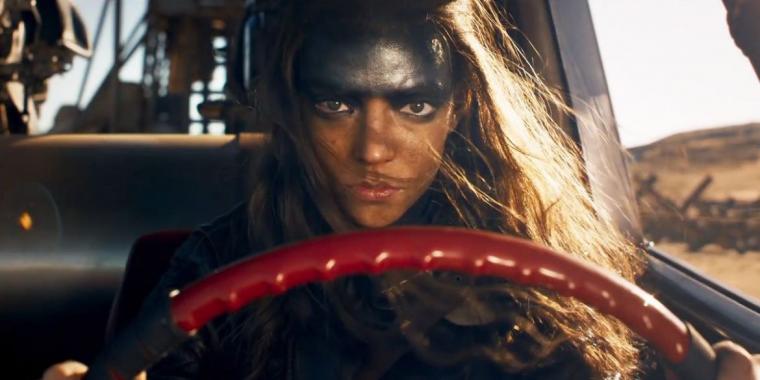
Anya Taylor-Joy in Furiosa: A Mad Max Saga
FURIOSA: A MAD MAX SAGA
It can sometimes take a while to get over a bad first impression. So if you see George Miller's prequel Furiosa: A Mad Max Saga and find yourself off-put by more than a few shaky visual effects (a motif that'll continue throughout the film's two-and-a-half hours), a number of colorless performances, a rather pushy degree of myth-building, and one of the most fraudulent fake noses of the past few decades, you'll likely find your early irritation largely forgotten by the finale. Unless you're a movie reviewer. Or you have a low tolerance for frenzied post-apocalyptic fables, acts of über-violence, and intimations of adult and pre-teen sexual servitude. Miller's long-awaited fifth series entry may be the least prototypically “fun” blockbuster to open over Memorial Day weekend since ... well, ever. But more often than not, it is fun. It also sticks in your gut and, less expectedly, your heart, despite somewhat fumbling the impossible challenge of reaching the high bar established in 2015.
That Mad Max installment was, of course, Fury Road, which earned massive summer-of-'15 dollars while enrapturing critics and eventually scoring six Oscars. (None of them, predictably but sadly, went to franchise guru Miller, whose original, 1979 Mad Max was followed by 1981's The Road Warrior and 1985's Beyond Thunderdome.) Almost inarguably the greatest English-language action adventure of the 21st century, Fury Road boasted physical stunts and chase sequences – nearly all of them CGI-free – you simply could not believe, as well as thematic resonance, a gloriously simple A-to-B-to-A plot, and world-building design that felt as though it had been in place for decades, if not centuries, before you entered the auditorium.
It also boasted Charlize Theron as the buzzcut bad-ass Imperator Furiosa, who quickly leapfrogged over Tom Hardy's Max to become the movie's true protagonist, as well as its raison d'etre. A prequel was almost bound to happen, and Furiosa does its share of pro forma prequel-izing, answering questions that no Fury Road devotee really needed the answers to. How did Furiosa get her mechanical arm? How was she first introduced to wasteland tyrant Immortan Joe? Why did this loner seem so uncharacteristically focused on Max's welfare? Happily, however, this Mad Max saga isn't mere fan service – not that this super-fan would have minded that much. Instead, it's a deeply considered (pre-)continuation, as well as a blast of pure filmmaking adrenaline suggesting that, like his heroine, 79-year-old Miller ain't slowing down any time soon.
As Furiosa opens, its title character (initially played by Alyla Browne) is around age 10, and the youth is first glimpsed in her Edenic forest community the Green Place of Many Mothers – presumably the only parcel of Australia to survive what a scene-setting voice-over onslaught describes (and what Mad Max devotees understand) as absolute global catastrophe: unsustainably high temperatures; water and oil shortages; wanton lawlessness. Not long after securing a pair of juicy, clearly symbolic peaches, Furiosa comes across a group of hellions disemboweling her horse, and despite her noble attempts at ransacking their motorbikes, she's captured, thrown aboard one of the bikes, and carted off to meet the cretins' warlord leader Dementus as proof of a better, hidden world waiting to be pillaged. All this takes up maybe the first 15 minutes of Furiosa, and despite a fair amount of visual and aural wonders, I was already kind of knee-deep in issues.
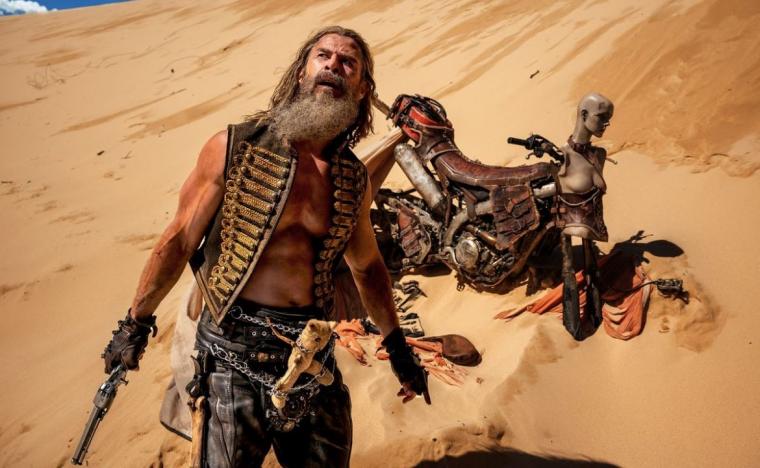
It's been a while since I revisited Fury Road, but although I distinctly recall the look of that Miller film to be fantastical, I also remember it – mostly because of the practicals – as an astounding exemplar of cinematic future-realism. The craziest shit kept happening, yet it all felt solid. There was a nearly tactile physicality behind the action – a sense that the movie existed on the same plane as the one that existed right outside the auditorium. After a couple of distractingly obvious green-screen effects landed early on here, it seemed as though F/X technology had somehow moved backward since 2015, and I was similarly thrown off when Dementus' henchmen tossed Furiosa onto their bike and drove off, because the “child” they absconded with was unquestionably no more human than a CPR dummy.
Even typing that, I have a hunch that George Miller might have been working one step ahead of me, because of course a prequel to a nine-year-old movie, in terms of visuals, should look less convincing than the work that chronologically followed. And maybe that line of thinking also encompasses the blatant fraudulence of Dementus' oversize nose, which, in its debut, is lit so that you can't help noticing exactly where the actor's actual facial features end and the prosthetics begin. The bigger problem is the actor sporting the faux schnoz, because it's Chris Hemsworth, and while great pains have been made to make him unrecognizable from the neck up, from neck down it's all Thor.
Between the generic baseness of the marauders and the generic nobility of Furiosa's determined, crack-shot mom (Charlee Fraser), the portrayals in Furiosa's first section are, at best, forgettable. Hemsworth, though, is apparently going for unforgettable – at least in the Grand Villain mode of The Dark Knight's Heath Ledger and Inglourious Basterds' Christoph Waltz – and the attempt is a misfire. Hemsworth is certainly going Big, making grand pronouncements into an old-timey microphone and driving a chariot motored by motorcycles (an excellent touch), and he's leaning into his natural Aussie dialect to the hilt. But while the externals work reasonably well, Hemsworth's soul doesn't feel invested in Dementus' nastiness, and he's never the terrifying presence he needs to be. You're aware of the actor reaching beyond his comfort zone (or at least his audience-approved zone), yet the performance isn't revelatory, or even interesting. It's just empty showboating, and Hemsworth's torso is its own detriment. This frequently shirtless Dementus has personal-trainer abs and musculature despite surely being the sort of guy who'd make his underlings do the heavy-lifting for him, and he maintains his enviable physique even after the events move 10-plus years ahead, when the now-gray-haired, now-desperate Dementus should definitely not resemble the body model for a Greek-god statue.
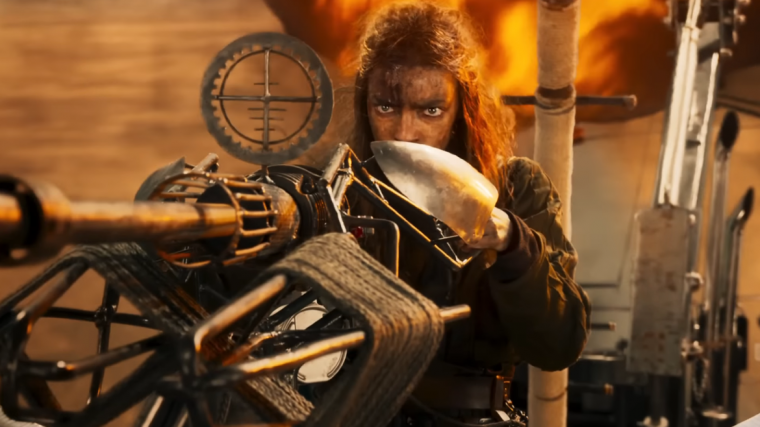
When covering movies I otherwise very much like, I try not to devote quite so many words to their failings. But I'm hoping to be forgiven for my approach this time, given that what I loved about Furiosa can't be easily expressed in words – at least not words anyone would want to read. Because Miller's action set pieces are astounding, and nothing kills the excitement of phenomenally well-executed stunt-work and choreography more than explanation. We're treated to a sublime sequence in which young Furiosa is saved, for not for long, through her mother's survivalist skills and the girl's brilliant severing of a bike's gasline with her teeth. Yet after time scoots forward and the steely-eyed, madly formidable Anya Taylor-Joy takes over the title role, Miller keeps knocking us silly with thunderously imaginative feats of dynamism that rival those in Fury Road, particularly when he employs parachutists and propellered gliders into the mix. All told, Miller's prequel is weirder and more elegiac than its predecessor – qualities that are their own rewards. But much of what we loved about the 2015 release is also in abundance here.
Barring occasionally spotty visuals, the tech and creative design are similarly wondrous, and it's gonna be a kick seeing how this film and the latest Dune – both of whose previous installments received a half-dozen Academy Awards apiece – fare in their inevitable face-offs for editing, production design, costuming, sound, and makeup/hairstyling Oscars next year. Despite her more slender frame, Taylor-Joy is a sensational proxy for Charlize Theron, and effortlessly holds the expanse of the narrative's drama in her interior fire, intensely limber physicality, and arresting, wide-set eyes. Midway through, Tom Burke shows up as the Citadel commander Praetorian Jack, and his stoic fierceness and incongruous gallantry immediately demonstrate why Furiosa would instinctively trust him … and also why she would/did take such a liking to Tom Hardy's Max nine years ago. Because he isn't referenced in Fury Road, we're crushingly aware that Jack likely won't survive to this film's end credits, and after so much gory bloodshed elsewhere, I wanted to applaud Miller and co-screenwriter Nico Lathouris for the admittedly painful yet relatively non-traumatic way they let Burke's creation vanish here. Burke's touching, soulful performance deserves the exit he's given.
If for no other reason, and there are loads of additional reasons, Furiosa: A Mad Max Saga would be worthwhile and then some for Miller's masterful confounding of expectation, as he routinely gives us scenarios and payoffs that are exactly right for the story but, theoretically, all wrong for traditional blockbuster entertainment. (And perhaps not just theoretically: Although Miller's movie topped the box office with some $32 million, it's the lowest Memorial Weekend domestic haul – not including the two major COVID years – in three decades.) We expect a horror show in the first confrontation between the brash Dementus and the feral Immortan Joe (Lachy Hulme, taking over for the departed, iconic Hugh Keays-Byrne); we get a simple gentleman's agreement. We expect clichèd getting-to-know-you fireworks when Furiosa and Jack first team up; they take to one another, and deeply, with intense speed. We expect a climactic, no-holds-barred free-for-all; it's instead a heartbreakingly sad, quiet encounter in the sand. For all of its presentational bells and whistles, Furiosa is almost an anti-blockbuster. Summer at the cineplex is here, and it's gonna be positively lousy with franchise continuations. Let's cross fingers for more of this one's type.

BABES
One of the great joys of moviegoing is encountering, for what feels like the first time, an established talent whose presence you somehow never registered before. In director Pamela Adlon's feature-film debut Babes, Michelle Buteau plays half of a pair of besties – the other half played by Broad City's Ilana Glazer – and the performer's credits indicate that I absolutely have seen her in such movies as Happiest Season and Marry Me and such TV series as Key & Peele and Russian Doll. Yet in this contemporary comedy of pregnancy and friendship co-written by Glazer and Josh Rabinowitz, Buteau, who has also been a standup comedian for nearly two decades, gives a performance of such richness, warmth, and delectable raunch that I can't imagine ever forgetting her now that I've witnessed her gifts in a leading role. She's utterly fantastic, and going forward, I hope she's given more opportunities to showcase her charisma and chops in movies just as funny though less awkward than this one.
Pals since grade school, Buteau's Dawn is a dentist living on the Upper West Side of Manhattan with her loving husband (an intensely charming Hasan Minhaj) and four-year-old son, and Glazer's Eden is a single yoga instructor living downtown in a (ludicrously spacious, given her salary) four-story walk-up. As Babes opens, the pair are enjoying their traditional Thanksgiving-morning ritual of seeing a movie together when Dawn's water breaks. A few weeks later, as the result of a condom-free tryst, Eden will also find herself pregnant, and Adlon's comedy consequently follows the duo as they deal with the effects of children – whether having them or preparing to have them – on their tight-knit friendship. Writer/director Nicole Holefcener excels at this sort of thing; in her more formulaic, mass-appeal way, so did Nora Ephron. Yet Adlon, who played Louis C.K.'s one true friend on Louie and enjoyed a major critical success with TV's Better Things, has a darker, more acerbic comic sense than either Holefcener or Ephron, and it doesn't quite mesh with the frequent goofiness of the situations that Glazer's and Rabinowitz's script provides.
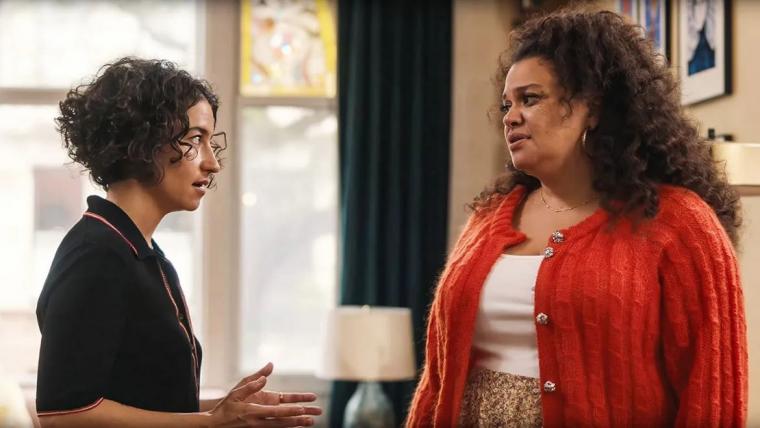
Aided by her completely in-sync performers, Adlon does wonderful work establishing and continuing the closeness of the leads' relationship, and Dawn's and Eden's bond is crystal clear whether they're trading increasingly baroque expressions of the love term “bitch” or, in one especially hurtful sequence, considering whether it's time to finally cut their figurative cord for good. When Babes is a comedy, it's routinely terrific; when it's a drama, it's frequently stunning. Most of the time here, though, is spent on comedy, and Adlon's realist bent has the unfortunate effect of making silly situations appear kind of strange and disruptive. In the first 10 minutes, it seemed a bit too sit-commy when Dawn and Eden decided to gorge on a huge meal at a chic Manhattan eatery rather than take the necessary trip to the ER. Yet with the sit-com played as genuine, our leads' behavior just felt bizarrely off, and we had only just met them. I experienced similar instances of “Huh?” with a number of later comic gambits, including the Omen fixation of Dawn's son and the running gag involving the hair pieces, or lack thereof, of Eden's OB/GYN (John Carroll Lynch, who redeems his one-joke role with beautifully subtle sardonic readings). And the means by which Eden's unintentional sperm donor Claude (a criminally underused Stephan James) vanishes are just slightly less ridiculous than his character's design – as an extra in a new Scorsese movie about vampires in Brooklyn. I'm all for suspension of disbelief at the movies, but I mean … . Please.
Glazer, too, is somewhat problematic, because as much as we believe in Eden's friendship with Dawn, we don't necessarily believe in Eden as a person. Instead, she seems a mere conglomeration of “wacky” single-gal traits and tics, and while she's definitely funny when demanding a full massage despite her late-term pregnancy or freaking out about the size of her epidural needle, it still reads as shtick. Still, Babes has just enough laughs and instances of credible behavior to warrant a viewing. (Oliver Platt is tremendous in the minor role of Eden's agoraphobic father.) Best of all, it has Michelle Buteau, and I couldn't have been more thrilled that the plural of the title was accurate – not in the sense of “babes” referring to the women and their babies, but in the sense of Glazer and Buteau emerging as true co-leads. A lesser achievement would've made Buteau the rock-solid black sidekick to Glazer's impregnated white lady, but Adlon's puts both on equal footing, consequently giving you no reason to ever ask “Why isn't this movie about Dawn instead?” It is. And whenever she's the focus – dealing with her crumbling house, her crumbling relationship with Eden, her crumbling ability to navigate a work/home balance – Babes is every bit the beauty I wish it had been all the way through.
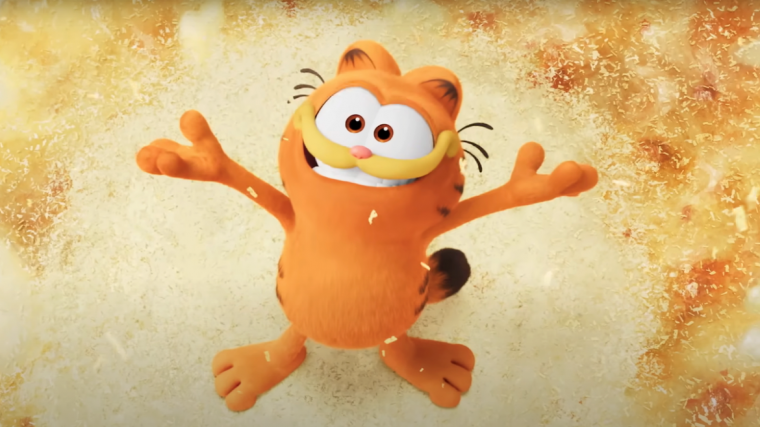
THE GARFIELD MOVIE
In Sony Pictures' animated The Garfield Movie, its titular tubby tabby is voiced by Chris Pratt, and in one of the more extraordinary admissions I've read this year, director Mark Dindal told Variety magazine that he had been “imagining [Pratt's] voice coming out of Garfield for years.” So my guess is that Dindal hasn't perused more than three or four Garfield comic strips since cartoonist Jim Davis created the series back in 1978. Maybe Davis, who's an executive producer on the film and gave a thumb's-up to the casting, hasn't perused them, either. Because despite being the current go-to guy for pricey Hollywood animations, no actor alive seems less well-suited to personify this particular cat.
Pratt's readings are full of sunniness and pep, which made him perfect for The Lego Movie and Pixar's Onward, and theoretically right for the personality-crushing void of The Super Mario Bros. Movie. But Pratt's himbo energy is all wrong for the grouchy, sarcastic, lasagna-loving, Monday-loathing feline that many of us grew up with. (The Bill Murray Garfields sucked, but at least their lead was an inspired vocal coup, and they were borderline faithful to the material.) Dindal's movie is also rife with other decisions that don't make a lick of sense to the Garfield-savvy. Owner Jim is now a nervous wreck with no social life, as his comic-strip girlfriend Liz is a voiceless cameo here. So is Garfield's nemesis Nermal, who first shows up roughly 30 seconds before the end credits. The adorably brainless pup Odie is now always the smartest one in the room – as designed here, the smartest one in any room. Before the plot gets rolling, we're given a lengthy catchup on Garfield's living situation, and at no point is his Teddy bear bestie Pookie referred to; when the cat returns home from his extended adventure and gives Pookie a big hug, the Garfield-ignorant among audiences must have wondered what the deal was. I could go on and on. But here's the thing: The Garfield Movie works. I'd even go so far as to call it the funniest animated slapstick I've seen since 2022's Puss in Boots: The Last Wish. To actively enjoy it, however, you have to agree to forget everything you ever knew about Garfield.

For me, this was no easy task, and there's plenty about Dindal's feature that any (adult) viewer might find annoying. The rampant product placement is pretty egregious – naturally, when Jon goes to sleep, it's while wearing a pair of Sony earphones – as is the film's over-reliance on character-defining flashbacks for heroes, villains, and randos alike. And because part of the comic strip's pleasure was that Garfield appeared to exist in a real world, behaving (and, you imagined, thinking) the way any surly fat cat in your life did, it's disorienting here when his animated likeness turns into a shape-shifting Looney Tunes figure, his body routinely stretched and contorted in familiar cartoon ways that are the antithesis of what Jim Davis accomplished. But Dindal was also the director of 2000's The Emperor's New Groove, a fourth-wall-breaking, pop-culture-referencing riot that remains Disney's most hilarious hand-drawn animation of the 21st century. The Garfield Movie may not be Garfield. But with Dindal seeming to take his cues from the New Groove approach, some of it evidenced in the inspired vocal pairings of Pulp Fiction's Samuel L. Jackson and Ving Rhames and Ted Lasso's Hannah Waddingham and Brett Goldstein, it's frequently its own kind of nutball blast – a movie you're frankly embarrassed to say you enjoyed as much as you did.
The plot involves a kidnapping that leads to Garfield and his long-estranged father (Jackson's Vic), with Odie in tow, forced to steal a milk truck from Lactose Farms (!) to satisfy a vengeful, sadistic kitty (Waddingham's Jinx) from Pop's past. The plot, happily, is utterly irrelevant. What matters are the dozens upon dozens of alternatively witty and deliriously silly visual and verbal gags, from the Wile E. Coyote suffering inflicted on Garfield and Vic to Garfield's description of purportedly alive roadkill as “Daniel Day-Possum.” There are so-inevitable-they're-hysterical needle drops involving the themes to Top Gun and Mission: Impossible, plus a priceless appropriation of Aaron Copland's “Hoedown.” An early question of mine – “Can humans here actually understand what the animals are saying?” – was answered in the cleverest possible way. At one point, one of the many snippy exchanges between Garfield and Rhames' morose bull Otto had me wiping away tears of laughter.
All told, given how much I was prepared to hate this thing, Dindal's feature was not, not, what I expected; even the sentimental father-and-son-reunion detours, which seemed rigged for unearned pathos, were unexpectedly moving. Your kids will likely have fun regardless. Enter with low expectations, though, and you, too, might find The Garfield Movie a hoot. Also: Catch it on a full stomach. Animation has become incrementally realistic over the years, but the realistic animation of pizza, for hungry viewers, has become positively cruel.










